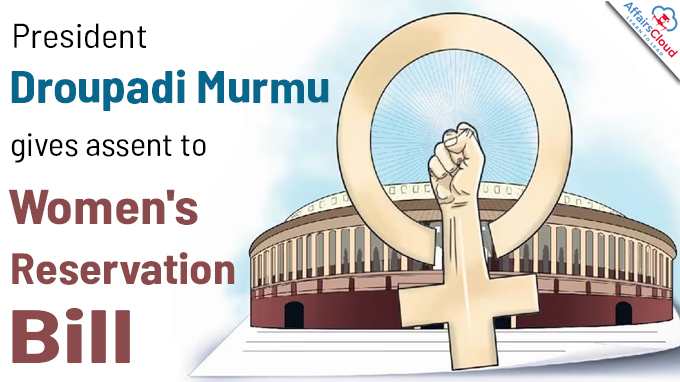
On September 29, 2023, as per the notification issued by the Union Law Minister Arjun Ram Meghwal ,President Droupadi Murmu has granted assent to the Women’s Reservation Bill 2023, which mandates a 33% reservation (one-third of total seats) for women in the Lok Sabha, State Legislative assemblies, and National Capital Territory (NCT) of Delhi. This historic decision was officially approved by the President on September 28, 2023.
- Vice President and Rajya Sabha Chairperson, Jagdeep Dhankhar on September 28 signed the women’s reservation Bill as passed by Parliament before it was presented to President Droupadi Murmu for her assent.
- Following the President’s assent, this Bill will be recognized as the Constitution (106th Amendment) Act.
- The Women’s Reservation Bill 2023, officially titled as The Constitution (128th Amendment) Bill, 2023 and commonly referred to as Nari Shakti Vandan Adhiniyam, has been introduced in the Indian Parliament.
- This bill, which aims to enhance gender representation, was introduced in the Lok Sabha on 19th September 2023 during a special parliamentary session.
- The Women’s Reservation Bill cannot be enacted into law until the year 2026.The bill can only become effective after a process known as “delimitation” is carried out in the country.Delimitation is necessary to allocate seats in the Lok Sabha and state legislative assemblies in a manner that reserves a specific percentage (in this case, 33 percent) for women.
Nari Shakti Vandan Adhiniyam
i.During the special session of Parliament, Prime Minister Narendra Modi had described the law as “Nari Shakti Vandan Adhiniyam.”
- The Indian Parliament Special Session, 2023 was a Special Session held in the Parliament of India from 18 to 22 September 2023.
- This special session witnessed the transfer of parliamentary proceedings from the existing premises to the New Parliament House, the Sansad Bhavan in New Delhi. Notably, this special session of Parliament did not incorporate Question Hour, Zero Hour, or Private Member Business.
- During this session, the Women’s Reservation Bill was introduced on September 19, 2023, which is the first bill to be presented in the new parliament building.
ii.The Nari Shakti Vandan Adhiniyam Bill, will also apply to seats reserved for Scheduled Castes (SCs) and Scheduled Tribes (STs) in the Lok Sabha and the State Legislative Assemblies.
- The demand for a separate OBC quota was also raised during the session.
Note: The present Bill does not include provisions for women’s reservation in the Rajya Sabha and State Legislative Councils. Rajya Sabha presently exhibits a lower representation of women compared to the Lok Sabha.
Summary of Women’s Reservation Bill, 2023
The Bill introduces major amendments in various articles of constitution by inserting new clauses.
(i) Reservation for Women in NCT of Delhi (New clause in 239AA):
In article 239AA of the Constitution,
- One-third of total Seats shall be reserved for women in the Legislative Assembly of the National Capital Territory of Delhi.
- About One-third of the seats will be reserved for the Scheduled Castes in the Legislative Assembly of the National Capital Territory of Delhi, one-third of these seats will be reserved for women.
- One-third of all directly elected seats in the assembly will be reserved for women. This includes seats reserved for women from Scheduled Castes as well.
(ii) Reservation of seats for women in the House of the People (Lok Sabha).
As per Article 330A, one-third of the total number of seats to be filled by direct election to the House of the People shall be reserved for women in the Lok Sabha.
- About one-third of the total number of seats shall be reserved for women belonging to the Scheduled Castes or the Scheduled Tribes.
(iii) Reservation for Women in State Legislative Assemblies:
- The Bill introduces Article 332A, which mandates the reservation of seats for women in every state Legislative Assembly.
- Additionally, one-third of the seats reserved for SCs and STs must be allocated for women, and one-third of the total seats filled through direct elections to the Legislative Assemblies shall also be reserved for women.
(iv) Commencement of Reservation:
- The New article – 334A is introduced, according to which the reservation will be effective after the census conducted after the commencement of this Bill has been published. Based on the census, delimitation will be undertaken to reserve seats for women.
- The reservation will be provided for a period of 15 years. However, it shall continue till such date as determined by a law made by Parliament.
(v) Rotation of Seats: The Bill provided that reserved seats for women may be allotted by rotation to different constituencies in states or Union Territories.
- In the seats reserved for SCs/STs, the Bill sought to provide one-third of the seats to be reserved for women on rotational basis.
- Seats reserved for women will be rotated after each delimitation, as determined by a law made by Parliament.
(vi) The Bill has been introduced with the objective of achieving the goal of becoming ‘Vikasit Bharat’ by 2047 and it would require contribution of all sections of society including women, constituting a half of the population. Following initiatives are mentioned in the bill:
- Spirit of ‘Sabka Saath, Sabka Vikas, Sabka Vishwas, Sabka Prayas’.
- Women led development, Women’s empowerment, financial independence, education, and health access for women.
- Ease of Living, measures like Ujjawala Yojana, Swacch Bharat Mission, and Mudra Yojna.
History of the Women Representation Bill:
i.Historical Roots: The issue of women’s reservation in Indian politics dates to the Indian national movement. In 1931, leaders like Begum Shah Nawaz and Sarojini Naidu advocated for women’s political representation through an official memorandum to then British Prime Minister.
ii.National Perspective Plan: In 1988, the National Perspective Plan for Women recommended reservation for women in politics from the panchayat level to the Parliament.
iii.Constitutional Amendments: The Constitution (73rd Amendment) Act, 1992, and the Constitution (74th Amendment) Act, 1992, introduced articles 243D and 243T, respectively, to provide reservations for women in Panchayats and Municipalities.
iv.Unsuccessful Attempts: Various bills were introduced to reserve one-third of seats for women in the House of the People and State Legislative Assemblies. The Constitution (81st Amendment) Bill, 1996, and subsequent bills in 1998, 1999, 2000, 2002, and 2003 faced challenges and failed to pass due to lack of consensus among political parties.
- The Constitution (84th Amendment) Bill, 1998, intended to reserve seats for women in Lok Sabha, State Assemblies, and Delhi Legislative Assembly. It lapsed with the 12th Lok Sabha dissolution, referred to the Geeta Mukherjee Committee.
Note: In 2006, Bihar became the first State to provide 50% reservation for women in panchayat bodies. At present, more than 20 States have 50% reservation for women at the panchayat level.
Statistics of Women Political Representation of India:
i.After implementation of this Act, there should be at least 181 (approximately 33.3% of seats) women members in the Lower House and 31 women in Rajya Sabha (13%).
- As of the current data, there are 82 women in the Lok Sabha, constituting 15% of its members. In the Rajya Sabha, there are 24 women, accounting for less than 10% of total seats.
ii.In 20 States & Union Territories (UTs) less than 10% Member of Legislative Assembly (MLAs) are female.
- This includes States such as Gujarat (2%), Maharashtra (8.3%), Andhra Pradesh (8%), Kerala (7.9%), Tamil Nadu (5.1%), Telangana (5%) and Karnataka (4.5%).
iii.Across party lines, women form just 13.5% of sitting members of the largest party in the Lower House, the Bharatiya Janata Party (BJP).
- The highest share of women MPs in the Lok Sabha are from the Biju Janata Dal (41.7%) followed by the Trinamool Congress (40.9%).
- The party-wise analysis of the State Legislative Assemblies shows that the Trinamool Congress in West Bengal had the highest share of women MLAs (3%) followed by the Congress in Chhattisgarh (14.7%).
- The Congress in Karnataka (3%), the Bharat Rashtra Samithi in Telangana (4%), and the Dravida Munnetra Kazhagam (DMK) in Tamil Nadu (4.5%) had among the lowest shares.
Women Representation in Parliament of India: A Global Perspective
i.The representation of women in India’s Parliament is among the lowest in the world. When compared with BRICS (Brazil, Russia, India, China, South Africa) nations, including the new members, India has the second-lowest representation of 15%, the second lowest after Iran’s 6%.
- According to recent UN Women data, Rwanda (61%), Cuba (53%), Nicaragua (52%) are the top three countries in women representation.
- Bangladesh (21%) and Pakistan (20%) as well are ahead of India in case of female representation.
ii.In the World Economy Forum (WEF)’s 2023 Global Gender Gap Report,India ranked 127 out of 146 countries in terms of gender parity.India’s performance in the domain of Political Empowerment, specifically the percentage of women in parliament, ranked 117th out of 146 countries.
About Delimitation:
i.Delimitation is the process of redrawing electoral boundaries for Lok Sabha and state Assembly constituencies based on the latest population data.The Delimitation Commission Act, established in 1952, governs the delimitation process in India.
- The President of India appoints the Delimitation Commission, which collaborates with the Election Commission of India.
ii.Delimitation aims to ensure that constituency sizes accurately reflect demographic changes and that each vote carries equal weight.
- Article 82 mandates the Parliament to enact a Delimitation Act after each Census to redefine Lok Sabha constituencies.
- Article 170 requires states to divide their territorial constituencies based on the Delimitation Act after every Census.
Note: The census, due in 2021, faced delays due to the Covid pandemic and there is no clarity yet on when it will be carried out now. Delimitation is considered as a necessary pre-requisite for implementing women’s reservations, as it determines which one-third of the seats will be reserved for women candidates. This process can be complex and time-consuming.
About Lok Sabha (House of People/Lower House)
- Speaker: Om Birla (Constituency-Kota), 17th speaker
- Maximum strength of till 2024 is 552.According to the 104th amendment in Constitution of India , it is 550.
About Rajya Sabha (Council of States/Upper House)
Ex-officio chairperson: Vice President of India- Sh. Jagdeep Dhankhar (14th)
Maximum strength: 250 members, Present strength of Rajya Sabha -245 members




